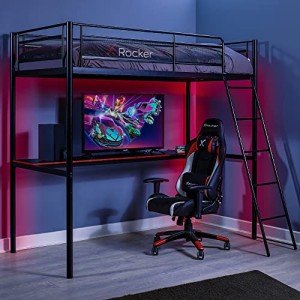The Ultimate Guide to Bunk Beds for Children: Safety, Styles, and Benefits
When it pertains to styling a child's room, parents typically deal with the double obstacle of taking full advantage of space while guaranteeing comfort and performance. Bunk beds have actually emerged as a popular solution that attends to these requirements, using not simply sleeping plans however also contributing to a room's visual. In this thorough guide, we will explore various aspects of children's bunk beds, focusing on their advantages, safety functions, designs, and factors to consider for moms and dads contemplating this purchase.
Tabulation
- Advantages of Bunk Beds
- Security Features to Consider
- Types of Bunk Beds
- Style and Style Options
- Maintenance Tips
- Frequently Asked Questions (FAQs)
1. Benefits of Bunk Beds
Bunk beds provide many benefits for kids and their parents. Here are some key benefits:
- Space-Efficiency: Bunk beds are an outstanding service for smaller spaces. By stacking please click the next web page on top of another, more floor space is readily available for play, storage, or research study areas.
- Economical: When children share spaces, bunk beds can reduce the need for buying 2 separate beds, hence saving cash.
- Promotes Social Interaction: Bunk beds can help siblings or pals bond by sharing a space, developing opportunities for social development.
- Enjoyable Factor: The principle of sleeping "up high" includes a playful element to bedtime, making the shift to sleeping alone simpler for some children.
- Versatile Design: Bunk beds come in numerous styles, colors, and designs to match any room style, permitting modification that shows the kid's personality.
2. Safety Features to Consider
Safety is critical when it comes to children's furniture, especially in the case of bunk beds. Here are some important security features to examine:
| Safety Feature | Description |
|---|---|
| Sturdy Construction | Frames made of solid wood or metal are preferred. |
| Guardrails | Must be at least 5 inches high and extend along both sides of the upper bunk. |
| Ladder Design | Ensure ladders are safely attached and have non-slip steps. |
| Mattress Size & & Fit | Should fit snugly within the frame to avoid gaps. |
| Weight Limit | Always follow the maker's weight limitation recommendations. |
3. Kinds Of Bunk Beds
Bunk beds come in a number of styles, accommodating different requirements, choices, and room sizes. Here are some common types:
- Standard Bunk Bed: The the majority of fundamental type, with one bed on top of another.
- Loft Bed: Features a high upper bed with space underneath for a desk or play location.
- Futon Bunk Bed: Combines a top bunk with a futon on the bottom, offering flexibility for seating and sleeping.
- L-Shaped Bunk Bed: This style has the leading bunk set at a perpendicular angle to the bottom, creating a little corner area.
- Triple Bunk Bed: Accommodates three children using stacked beds, suitable for big households or sleepovers.
4. Design and Style Options
When it pertains to selecting a style for children's bunk beds, the alternatives are essentially limitless. Here are some popular designs:
- Traditional Style: Often made from wood, these bunk beds feature ornate information and are best for traditional or rustic-themed spaces.
- Modern Style: Characterized by clean lines and minimalist styles, modern-day bunk beds can be made of metal or wood.
- Themed Bunk Beds: Some brand names use bunk beds shaped like castles, vehicles, or play houses, making bedtime less of a chore.
- Convertible Bunk Beds: These can be separated into 2 individual beds, offering versatility as children grow.
- Colorful Options: Bunk beds in vibrant colors can include a sense of joy and playfulness to any space.
5. Upkeep Tips
Keeping a bunk bed is essential for durability and safety. Here are some ideas:
- Regular Inspections: Check for loose screws or bolts every couple of months and tighten them as needed.
- Cleaning up: Wipe down frames regularly to avoid dust accumulation; think about utilizing a vacuum for hard-to-reach areas.
- Bed mattress Care: Rotate mattresses frequently and use protective covers to extend their life.
- Expect Wear and Tear: Look for any indications of damage in the wood or metal and think about changing parts if necessary.
- Teach Kids Safety Rules: Encourage children to use ladders correctly and guarantee they understand the safety functions of their bed.
6. Frequently Asked Questions (FAQs)
Q1: What age is proper for sleeping in a top bunk?
A1: Typically, kids aged 6 and older are suggested for upper bunk sleeping, as they have the needed motor abilities to climb safely.
Q2: Do bunk beds feature a mattress?
A2: Most bunk beds are sold as frames only, so you will need to buy mattresses separately. Guarantee that the mattress fits the frame comfortably.
Q3: Can bunk beds be separated later?
A3: Many styles enable conversion into 2 private beds, providing versatility for future needs.
Q4: How can I guarantee my kid's security on a bunk bed?
A4: Comply with security standards and make sure guardrails, a strong frame, and a secured ladder are in place.
Q5: Are there weight limits on bunk beds?
A5: Yes, constantly examine the manufacturer's requirements concerning weight limits to make sure safety.
Bunk beds for children can serve numerous purposes while guaranteeing safety and design. With varied styles and designs available on the marketplace, parents can discover a system that not only optimizes bedroom space however likewise reflects their child's unique tastes. Just like any furnishings, understanding security features, upkeep, and how they fit into a child's way of life will ensure that these beds stay a useful furniture option for years to come.
Through cautious consideration and adherence to safety standards, bunk beds can supply a lasting, fun, and practical sleeping option that children like.

